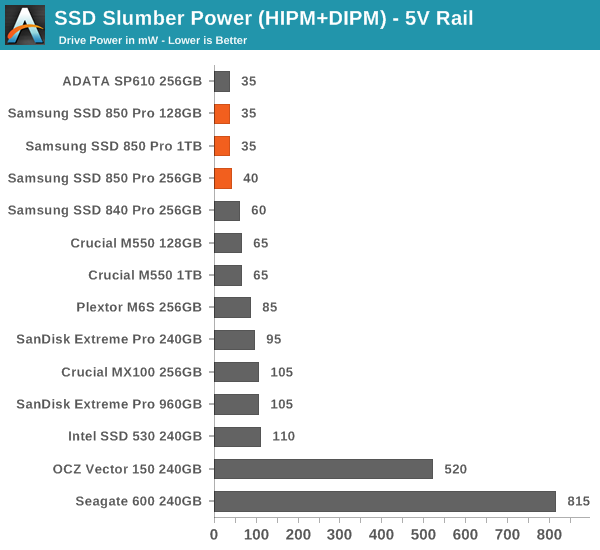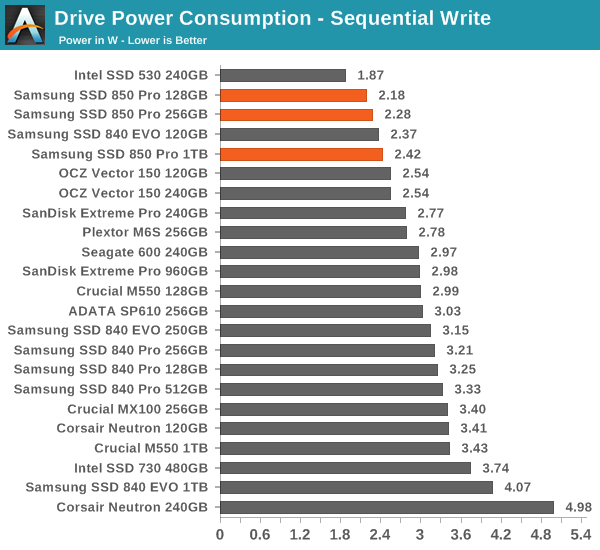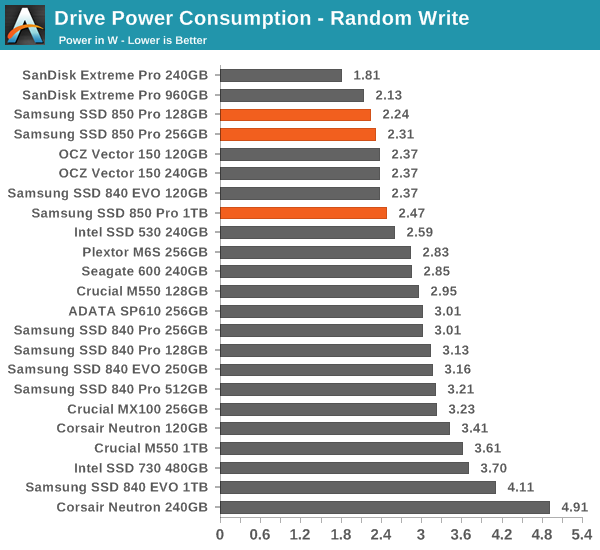Samsung SSD 850 Pro (128GB, 256GB & 1TB) Review: Enter the 3D Era
by Kristian Vättö on July 1, 2014 10:00 AM ESTPower Consumption
Samsung has always been pushing hard with power consumption and the 850 Pro is another proof of their efforts. Slumber power is down by a bit compared to the 840 Pro and generally speaking the 850 Pro is one of the most efficient drives. Even load power consumption stays at below 2.5W, which is superb given the performance of the 850 Pro.













160 Comments
View All Comments
beginner99 - Tuesday, July 1, 2014 - link
Sounds great until you see the price. Even for an enthusiast a crucial MX100 is probably the more reasonable choice. It's half the price...juhatus - Tuesday, July 1, 2014 - link
Yeah, the most important factor of a SATA SSD is the price, not how it will saturate the 550Mb limit in a scenario that will never happen for most consumers. Now even a mention on the first page, eh? Please put a little pressure for the manufacturers to move on to M.2 and NVME.**In the Midnight hour, She cried more, more, more!!**
boogerlad - Tuesday, July 1, 2014 - link
Are you guys going to review the SM1715? Really curious to see how it stacks up against the Intel, especially in client workloads.pesho00 - Tuesday, July 1, 2014 - link
I realy hoped to see 2,3,4 TB drives with this technology :(But we will weith ;)
Nice drive, not so nice price ;)
MrSpadge - Tuesday, July 1, 2014 - link
Not much point in offering them now if you consider the price of the 1 TB version.Samus - Tuesday, July 1, 2014 - link
Those Koreans...they're just killer engineers.trumanhw - Tuesday, July 1, 2014 - link
I don't get it. I get about 505 read and 495 write on Evo. This goes up by TEN percent in performance and then all but DOUBLES the price?I'm confident someone here has understanding of this I'm missing--please reply and just point me to the parts that change my view.
Thanks
hojnikb - Tuesday, July 1, 2014 - link
Your EVO has worse endurance, lower IOPS, lower consistency and most of all lower Write speeds (495MB/s write is due to trick called turbowrite).Sequential speeds are only a part of the story.
emn13 - Tuesday, July 1, 2014 - link
I always wonder who this kind of drive is supposed to be aimed at. Yes, it's fast; but the competition is fast enough that I really can't imagine anyone *noticing* the difference outside of artificial extremely heavy non-stop I/O. And I don't mean light-load non-stop, I mean I/O's maxed out non-stop so the drives can't take time to garbage collect.So... a power user is unlikely to notice much difference outside of short bursts of high-I/O apps, and as the rather heavy 2011 light load demonstrates, the drives are already maxing out there too. I just can't think of a real-world load where a human being would notice the performance difference and care about it; that would imply a performance difference of around a factor 2.
So we're left with a super fast drive (good for bragging rights, but what else?), but some apparently intentionally missing features like power-loss protection. Why would even a heavy user choose this over, say, samsungs own 840 EVO, or crucial's MX100/M500?
I just don't see the value here. To me this looks like microoptimization and losing sight of the bigger picture.
Price matters. Features matter. Performance - only until you're fast enough.
hojnikb - Tuesday, July 1, 2014 - link
Kinga agree with this. If you REALLY need every bit of performance, you won't be looking for SATA drives at all.This probobly has a nieche.
But mainstream drives are really fast enough these days for most people.